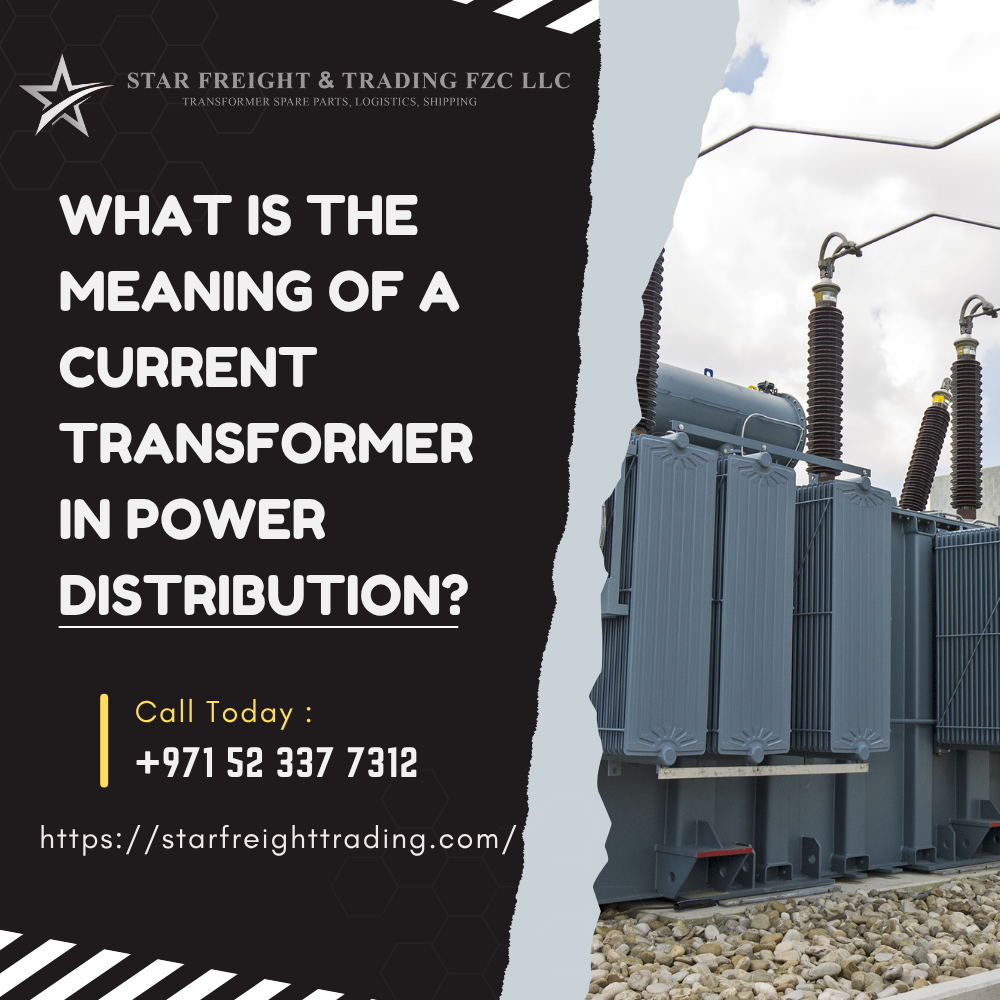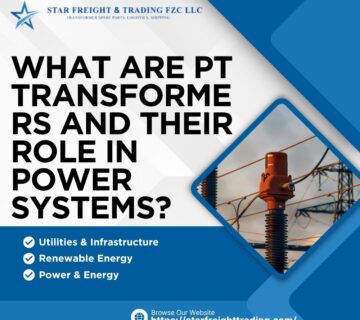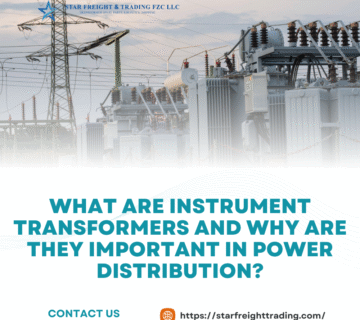If you work in electrical systems, you’ve probably heard the term “Current Transformer” or CT. These devices are not just another piece of hardware in a substation; they are the bridge between high-power electrical networks and the instruments we use to measure and protect them.
In this post, we’ll break down what a current transformer is, why it matters in power distribution, how it works, and the role it plays in ensuring safety and efficiency. We’ll also look at how companies in the UAE, including Star Freight Trading, use CTs in real-world applications. Blogs
What Is a Current Transformer?
A current transformer is a type of transformer designed specifically to measure alternating current (AC). Its primary job is to step down high currents flowing through power lines into smaller, safer values. This allows meters, relays, and other monitoring devices to measure the current without being directly exposed to dangerous levels.
Think of a CT as a translator. On one side, it sees large, high-energy currents that could damage sensitive instruments. On the other side, it delivers a scaled-down, accurate version of that current to devices that can safely record and analyze it. Products
Why Do We Need Current Transformers?
In power distribution, currents can reach thousands of amps. Directly connecting measuring instruments to such levels would be dangerous, expensive, and impractical. CTs solve three main problems:
-
Safety
By reducing current to manageable levels, CTs protect technicians and equipment from hazards. -
Accuracy
Electrical meters and protection relays work best within a specific current range. CTs bring large currents into that range while maintaining proportional accuracy. -
Isolation
CTs provide electrical isolation between high-voltage circuits and measuring equipment, reducing the risk of electrical shock.
How a Current Transformer Works
A CT operates on the same principle as any transformer: electromagnetic induction. It has a primary winding, a magnetic core, and a secondary winding.
-
Primary winding: This can be just a single conductor (like a busbar or cable) carrying the high current.
-
Magnetic core: Directs the magnetic field generated by the primary current.
-
Secondary winding: Wound with more turns, producing a lower current proportional to the primary current.
The key is that the ratio of the primary to secondary windings determines the step-down factor. For example, a CT with a 100:5 ratio will output 5 amps on the secondary when 100 amps flow through the primary.
Types of Current Transformers
CTs come in several designs, each suited to different applications:
-
Wound CTs
The primary winding has multiple turns. They are often used in low-current applications where higher accuracy is needed. -
Toroidal CTs
These have no primary winding. The conductor carrying the current passes through the CT’s core. -
Bar-type CTs
Use a solid bar as the primary winding. These are robust and common in high-current industrial applications. -
Split-core CTs
Can be opened and clamped around an existing conductor, making them ideal for retrofitting without disconnecting the circuit.
Current Transformers in Power Distribution Networks
In the UAE’s power infrastructure, CTs play a critical role in both transmission and distribution networks. Here’s where they are commonly used: Our Services
-
Substations
CTs monitor current flow on high-voltage lines and feed data to protection relays. If the current exceeds safe levels, the relay trips the circuit breaker. -
Industrial Facilities
Large factories and plants rely on CTs to keep track of energy use and detect overloads before they damage equipment. -
Commercial Buildings
CTs integrate with energy management systems to monitor and control consumption.
Accuracy Classes and Standards
Not all CTs are created equal. Their performance is defined by accuracy classes, which specify how closely the CT’s output matches the actual current. International standards like IEC 60044 or IEC 61869 define these classes. For instance:
-
Class 0.2 or 0.5: Very high accuracy, used in billing meters.
-
Class 1 or 3: Adequate for general monitoring.
-
Protection classes (e.g., 5P, 10P): Designed for relays and fault detection rather than precise measurement.
Installation Considerations
Installing a CT is not just about clamping it on and connecting wires. Several factors matter:
-
Correct Ratio: Match the CT’s ratio to the expected current range.
-
Burden: The load connected to the CT’s secondary must be within limits for accurate operation.
-
Polarity: The primary and secondary must be connected correctly to maintain measurement accuracy.
-
Grounding: One side of the secondary should be grounded for safety.
Safety Precautions
One of the golden rules of working with CTs: Never open-circuit the secondary while the primary is energized.
Doing so can cause dangerously high voltages to appear on the secondary, risking equipment damage and personal injury.
Role of Star Freight Trading in the UAE Market
In the UAE, where industrial growth and infrastructure expansion demand reliable power systems, companies like Star Freight Trading supply and support electrical components, including current transformers. With their expertise in sourcing high-quality CTs and related equipment, they help clients in sectors such as manufacturing, construction, and utilities maintain safe and efficient power distribution.
Star Freight Trading’s portfolio includes CTs suited for a variety of applications, from compact split-core units for building retrofits to heavy-duty bar-type models for high-voltage substations. Their technical guidance ensures clients choose the right CT for each job, aligning with both IEC standards and local regulations.
Real-World Example: Energy Management in a Manufacturing Plant
Consider a large manufacturing facility in Abu Dhabi consuming several megawatts of power. Without CTs, monitoring and controlling energy use would be nearly impossible. By installing CTs at key distribution panels, the facility’s energy management system can:
-
Track real-time current draw.
-
Detect abnormal load patterns before they cause equipment failures.
-
Generate accurate consumption reports for cost allocation.
This data allows management to reduce wastage and improve efficiency, directly impacting the bottom line.
The Future of Current Transformers
As the UAE moves toward smart grids and more advanced energy systems, CTs are evolving too. Modern designs now integrate:
-
Digital outputs for direct connection to SCADA and IoT systems.
-
Higher accuracy for dynamic load monitoring.
-
Compact designs to fit into space-constrained switchgear.
For businesses aiming to keep pace with technology, working with suppliers like Star Freight Trading ensures access to CTs that meet future needs.
Conclusion
Current transformers are more than just passive components in a power system. They are essential for safety, accurate measurement, and efficient power management. In a country like the UAE, with its mix of heavy industry, commercial growth, and ambitious infrastructure projects, the role of CTs will only grow.
Companies such as Star Freight Trading are positioned to supply the right solutions, ensuring that both traditional and modern electrical systems remain safe, reliable, and ready for the challenges ahead.
Frequently Ask Questions
1. What is meant by current transformer?
A current transformer (CT) is an electrical device that reduces high alternating current (AC) to a smaller, proportional value. This allows safe and accurate measurement, monitoring, and control in power systems.
2. Why use a current transformer?
CTs are used to measure high currents without exposing meters or operators to dangerous levels, to protect equipment, and to provide electrical isolation between high-voltage circuits and measuring instruments.
3. What is the main function of CT?
The main function of a CT is to step down large AC currents to a safe, measurable level while maintaining accurate proportionality to the original current.
4. What are CT and PT used for?
-
CT (Current Transformer): Measures current and supplies input to meters and protection relays.
-
PT (Potential Transformer): Steps down high voltage to a lower level for safe measurement and monitoring.
5. What are the advantages of current transformer?
-
Enables safe current measurement.
-
Provides electrical isolation.
-
Supports accurate metering and protection.
-
Handles high currents without damaging instruments.
-
Works in a wide range of industrial and utility applications.
6. Why is CT used in electrical?
CTs are used in electrical systems to monitor load, detect faults, and enable protective devices to operate correctly while keeping both equipment and personnel safe.





No comment